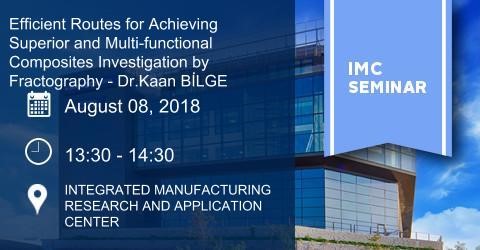IMC SEMINAR:Fractography to achieve superior&multi-functional composites
SEMINAR ANNOUNCEMENT :

Title : Efficient routes for achieving superior and multi-functional composites: Investigation by Fractography.
Speaker : Dr.Kaan BİLGE
Time : August 08, 2018, 13:30-14:30
Place : Teknopark- KTMM
Abstract:
The key point of this talk is the relation between constituent choice, mechanical test response and how this response is monitored by fracture surface analysis for polymeric composites. Several case studies for different polymer composites are presented in order to create a common understanding on constitutive relations for composite materials.
In the first case study, a unique technique for determination of inherent susceptibilities for laminated composites causing pre-mature failure is presented. Acoustic outputs generated from cross-ply laminates under tension are used hereby to identify the failure regimes. Interlayer toughening is then proposed as a novel method to manufacture more resistant composites. Examples for both in-plane test efforts and high strain deformation associated with interlayer modification are presented. By putting the fracture surface analysis as the common ground, an example for macro-scale effect of a molecular level alteration is exemplified.
As a final example, failure of highly hybridized multi-functional composite laminates is presented. Mechanical and electrical properties of structural power composites formed of a conductive phase (modified carbon fabrics), a solid electrolyte (modified resin) and separator (a thin insulator) is explained by detailed fracture surface analysis. Routes for efficient multi-functional composite design are then offered for future works. As a side message this talk aims to provide the importance of the analysis of fracture surfaces that sheds light to superior composite designs.
Biograph:
Dr. Bilge has received his BSc.(2009), MSc (2013) and PhD (2017) degrees from Sabanci University Materials Science and Engineering department. His recent employment was in Imperial College London, Department of Aeronautics.
Dr. Bilge has been actively involved in research on composite materials from his early BSc. He initially meet the world of composite materials by conducting research on ‘Micromechanics of failure for composite materials’ where he practiced several aspects like composite manufacturing, testing and property predictions by finite elements method for non-crimp glass fiber composites. He offered response surface based surrogate models for stress amplification factors employed in MMF in a collaborative TUBITAK project with ROKETSAN A.S and METYX A.S. in the supervision of Prof. Melih Papila. His foundings were employed in the design of filament wound CFRP and GFRP tubes. Simultaneously, he was able to actively participate in research efforts on hybrid composites where he synthesized/manufactured and applied polymeric nanofibers to CFRP based laminated composites as interlayer toughening agents. He is one of the pioneers on that subject in Turkey. Combining all of these efforts , his MSc thesis was named “Multi-Scaled Nature of Composite Materials”. Luckily, in his early career he was able to discover the response of composites in every length scale (nano:Interlayer toughening, micro: micromechanics of failure, meso: NCF composites, macro: Filament wound tube testing) and transition of properties between these length scales.
Having achieved scientific edges on several aspects of composites science, during the first year of his PhD he was able to submit a new TUBITAK project where the main aim was to alter the chemistry (molecular scale) of polymeric nanofibers in order to override polymer related material boundaries (e.g. glass transition temperature) that limits the application of these materials to structural composites which demands usually harsh processing conditions. During his PhD his main focus was to visualize, measure and tune the interfaces available in a composite material (interlaminar region, nano fiber/matrix interface) which led him to conduct serious efforts on SEM based fracture surface analysis. As a member of Advanced Composites and Polymer Porcessig (AC2PL) group his skills on mechanical testing and fracture surface analysis was commonly being demanded from other research groups in SU. With these collaborative works he had chance to conduct mechanical tests on green composites, elastomeric composites, thermoplastic elastomers and has successfully conducted failure analysis that lead to scientific publications as well as national scientific awards.
By enlarging his point of view towards multi-functional composites, Dr. Bilge has participated in a third collaborative TUBITAK project where the aim was to optimize the synthesis of new generation Boron Nitride Nanotubes (BNNT) and manufacture fast curing and mechanically superior BNNT/epoxy nanocomposites.
During his PhD, Dr. Bilge has published 12 peer reviewed articles in prestigious journals on composite (Composites Science and Technology, Composites Part A, Composites Structures) and material science (Nanoscale). He co-authored 2 book chapters on interlayer toughening and micro-CT analysis of non-crimp composites. Dr. Bilge holds 1 US PATENT on nanofiber chemistry and 1 National Patent on nanotube synthesis.
These achievements has recently granted him a Post-Doc research associate position in Imperial College, London where he worked on multi-functional composites named as structural power composites under the supervision of Prof. Emile Greenhalgh (one of the key scientist in fracture surface analysis of composites). As a member of a large (6 Universities, Airbus, Rolls Royce) ESPRC funded project his duty was to propose correct separator choices in order to improve electrical and mechanical output of these new generation super capacitor composite materials. He was also responsible of forming a new laboratory on Multi-Functional Composites laboratory with capabilities ranging from inorganic material synthesis to composite manufacturing.
Within a one-year project framework, he significantly enlarged his expertise on fracture surface analysis and multi-scaled relations between constituents in laminated composites.
In overall, he has a wide area of research on composite materials and he is keen on investigating constituent based relations by the means of mechanical testing, fracture surface analysis and correlate these foundings with appropriate material models for finite element based property predictions.
For more info:
https://www.researchgate.net/profile/Kaan_Bilge
https://scholar.google.com.tr/citations?user=GVJ3lTkAAAAJ&hl=en
Kampüs-Teknopark Arası Araç Bilgisi:
Sabancı Üniversitesi -Teknopark Gidiş
Araç Hareket Saati : 13:00Araç Hareket Alanı : Sunum Binası Önü
Teknopark- Sabancı Üniversitesi Dönüş
Araç Hareket Saati : 15:30
Araç Hareket Alanı : KTMM Binası Önü